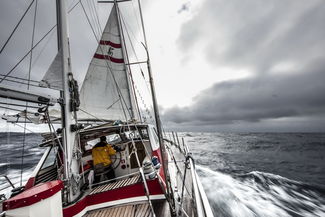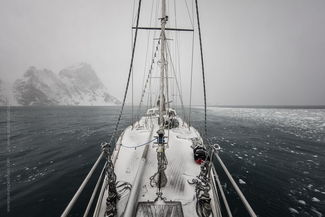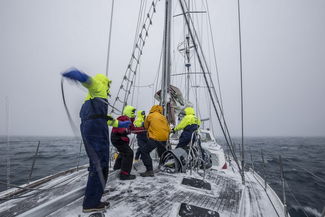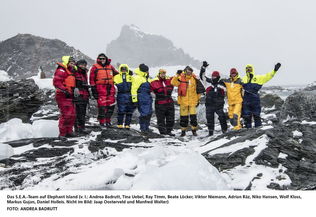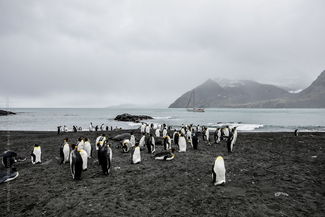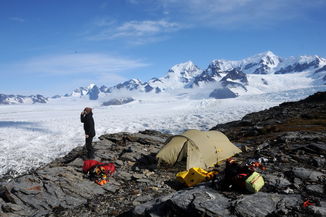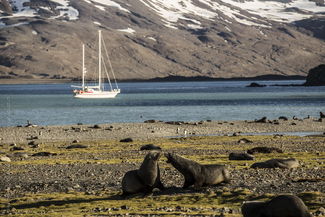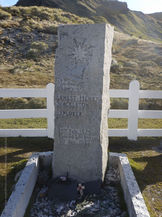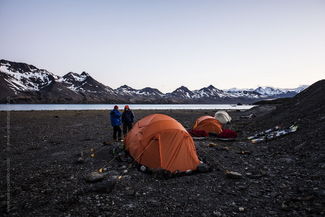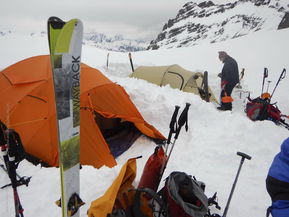S-E-A Expedition - In Shackelton’s footprints
February 09, 2016
The expedition „S.E.A. – Sir Ernest’s Anniversary“, honoring the centennial of the „Endurance“ Expedition by following the way of legendary polar explorer Ernest Shackleton after the sinking of his ship in the Weddell Sea, returned safely to Port Stanley on the Falkland Islands. The multinational team of twelve sailors and mountaineers has achieved all of the expedition’s aspirations.
On December 5th the complete team unites on the Falkland Islands – the „Santa Maria Australis“, with captain Wolf Kloss and crew Beate Löcker and Daniel Holleis having arrived a few days, Markus Gujan, Adrian Räz, Andrea Badrutt, Manfred Walter, Ray Timm und Jaap Oosterveld a full week before.
Not arriving together with the last team members Niko Hansen, Viktor Niemann and Tina Uebel is a big duffel bag, containing vital expedition equipment, which was lost by the airline – and flights to the Falklands are scheduled only once a week. Little of the lost gear can be substituted in Port Stanley, we are compelled to borrow, improvise, make do without it.
On December 7th we set sail toward Elephant Island – the inhospitable antarctic island reached 1916 by Shackleton’s men after the loss of the „Endurance“, and months of drifting on the pack ice. For the 560 nautical miles through the Drake Passage, the most notorious part of the world’s oceans, we try to catch a lull inbetween two storms.
Only 24 hours later we are caught in a race against the next approaching storm, which under no circumstances must catch up with us on, or close to, the Burdwood Bank: There the bottom of the ocean rises abruptly from 4.000 meters to a depth of just 100 meters. Which means that the massive seas of the Southern Ocean, reaching easily a height of 20, 30 meters in a storm, get compressed and build up to enormous walls of water. Sailing around the Burdwood Bank would mean losing several days, and beating back up against the prevailing westerly winds. But eventually we win the race – when the storm hits us, we have just cleared the bank with a sufficient margin.
The storm is building up to hurricane force. We reach Elephant Island on December 11th, in a blizzard, force 12 Beaufort, gusts of 75 knots, 140 km/h. On third try we manage to anchor in what we assume to be the famous bay at Cape Wild – the visibility is nearly zero, and the charts are amazingly inaccurate. This is where Shackleton’s men were forced to winter during four months, waiting for a rescue mission by Shackleton himself, who left with five of his men in the small whaling boat „James Caird“ towards South Georgia.
We are taking turns with anchor watches during the storm-lashed night, the next day we bring out the dinghy under considerable difficulties and ferry over to the beach. The first landing has to be aborted quickly, owed to the gale, in the afternoon the conditions calm down a little. We step ashore with nothing less than awe, on to a „kind of holy ground“, as one of us calls ist. A more brutal weather than yesterday’s hurricane is hard to imagine, and still: this was a summer storm.
Winter conditions here, and how to survive in them with thread -bare clothing and hardly any food or equipment, sheltering under two small upturned boats – it exceeds our imagination. The following day, the gale still blowing, we hoist anchor and set course to South Georgia: The famous 700 miles the „James Caird“ covered in 16 days. An epic nautical achievement and testimony to men’s incredible, tenacious will to survive.
In the early morning hours of December 18th we reach King Haakon Bay, with the forecast of a perfect intermission in the nearly constant storms. Immediately we begin to shuttle our equipment for the traverse ashore, and set up our first camp. In the evening the traverse team – expedition leader Markus, his fellow mountain guide Adrian, Andrea, Wolf, Ray, Tina and Manfred – starts carrying gear up to the first snowfields at the head of the bay, from where we pressumably will get access on to the first glacier.
We will follow the route of Shackleton, Worsley and Crean across the mountains and glaciers of the island’s interior, which the men traversed in a forced 36-hours march, to reach the whaling stations on the east coast. Back then the island was completely uncharted, and even today the available maps are sparse and more than vague. We break camp early the next morning. With a long days march Markus and Adrian are aiming to negotiate the crux if possible today: A steep precipice at the four passes below the Tridents. We don’t quite make it.
After the ascent over the first glacier, through the Shackleton Gap, crossing the Murry Snowfield and ascending to the passes, we reach the latter only around 5:30 p.m., pitching camp below them in the shelter of a crag. Since the harness-frames for the pulkas were in the lost duffel bag, we have to pull the pulkas with ropes, which slows us down when going downhill or traversing steep slopes. But we are immensely lucky with the weather: For these latitudes it is nearly windless, the sky is cloudy, so we are having a firm snow cover and hardly any crevasses.
After supper Markus and Adrian reconnoiter the two possible passes, and decide on the very same one which Shackleton took. On the next morning we wait till 9 a.m. before starting, hoping for the icy slopes to soften a little. Rigging up a pulley, we haul the pulkas up to the pass, on the other side they have to be abseiled. Our three ropes, joined, make up 160 meters; with abseiling three times on the 40° decline we get down on to the Crean Glacier, after four hours altogether. Here we rope up, as we have seen from above that we will now have to face crevassed terrain. In the evening, the wind having picked up, we dig our camp into the snow on the Crean Glacier.
The following day starts off sunny, but over the course of the morning it is clouding over, and we are walking several hours in driving snow and near white-out conditions. After crossing over the ridge towards Fortuna Bay the weather clears, and we can find our way down over the Fortuna Glacier by the light of the evening sun. After setting up our final camp at the shore, the „Santa Maria Australis“ enters the bay and throws anchor. Tomorrow she will already take abord the gear we won’t need anymore: Tents, pulkas, ski.
On the last leg of the Shackleton Traverse, a pass over the mountains on the other side of the bay, Niko, Jaap and Viktor are joining us. We are seeking our way through intensifying fog, and are picked up by the „Santa Maria Australis“ in the afternoon at the abandoned whaling station Stromness. Christmas Eve we are celebrating in Grytviken, at an exuberant communal „Christmas Carol Service“ in the historical wooden church, fuelled by hot spicy wine, together with the personnel of the King Edward Point station and the crew of the fishery patrol vessel „Pharos“.
On Christmas Day our boat is dropping off six of us, Markus, Adrian, Wolf, Ray, Tina and Manfred, at the foot of the Nordenskjöld Glacier in Cumberland East Bay, for another four days of excursion into the Allardyce Range, while the rest of the team will continue exploring the coasts. The Nordenskjöld Glacier is snowless and severely crevassed, therefore inaccessible. We spend the first day searching for a route along the lateral moraine, until we can set up a base camp high above the glacier.
From here we set out during the next days, ascending, across secondary glaciers, three minor peaks of the Allardyce, below Mount Paget. On the map these peaks are neither defined nor named, it might possibly be first ascents. Rendezvous with „Santa Maria Australis“ on the evening of December 28th down at the bay; because of drifting ice floes the pick-up of team and gear from the beach is tricky.
We spend two more days along South Georgia’s coast, slowly heading north, visiting the huge King Penguin colony at Salisbury Plain. Around noon on December 31st we embark on the return journey, to catch another period of not too unfavorable winds. After a rather – for the Southern Ocean – calm passage we return to Port Stanley on the 5th of January – the day of Shackleton’s death – with the exhilarating feeling of having accomplished all our expedi - tion’s goals.
+ The book about the expedition will be published September 2016 by Malik Verlag +
